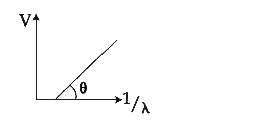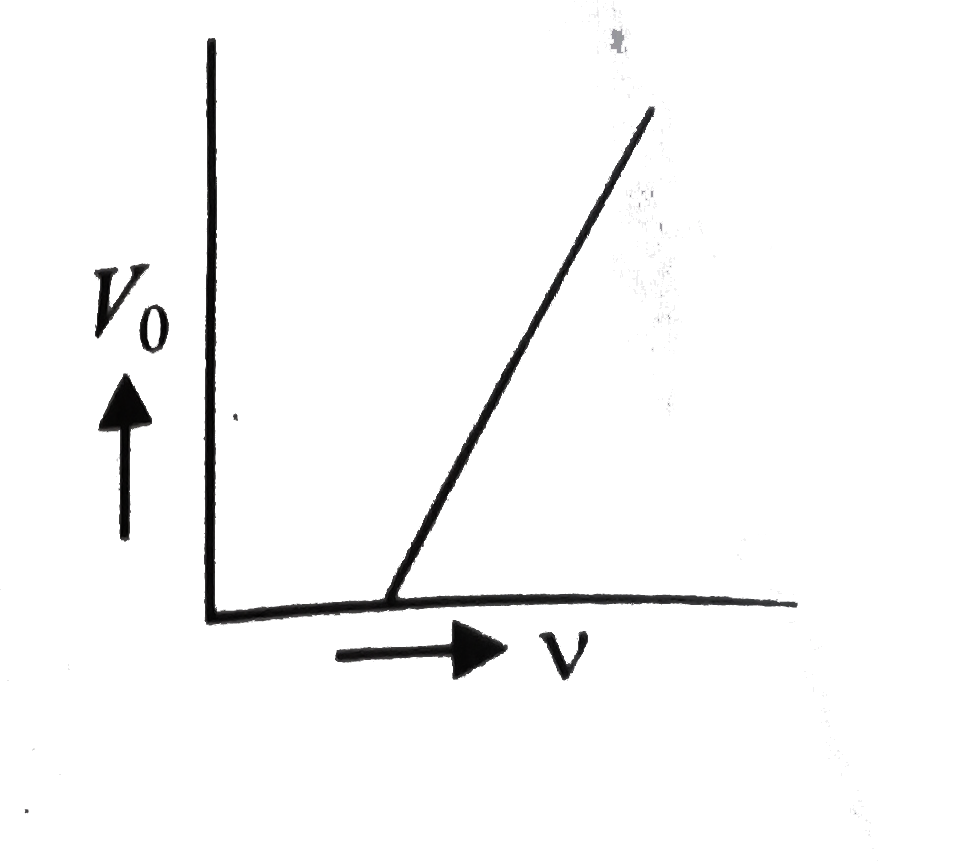In photoelectric effect the slope of stop of stopping potential versus frequency of incident light for a given surface will be
slope is different for different metals
threshold frequency does not vary with emitter
the slope is universal constant equal to (h/e)
stopping potential decreases with increasing frequency of incident light
The correct Answer is:C
To solve the problem regarding the slope of the stopping potential versus frequency of incident light in the photoelectric effect, we can follow these steps:
Step 1: Understand the relationship between stopping potential and frequency
The stopping potential (V₀) is related to the maximum kinetic energy (KE_max) of the ejected electrons. The maximum kinetic energy can be expressed as:
KEmax=hν−hν0
where:
- h is Planck's constant,
- ν is the frequency of the incident light,
- ν0 is the threshold frequency.
Step 2: Relate kinetic energy to stopping potential
The stopping potential is defined as:
V0=KEmaxe
where e is the charge of the electron. Substituting the expression for KEmax:
V0=hν−hν0e
Step 3: Rearranging the equation
We can rearrange the equation to express V0 in terms of ν:
V0=heν−hν0e
Step 4: Identify the slope of the graph
This equation is in the form of y=mx+c, where:
- y is V0,
- m is the slope,
- x is ν,
- c is the y-intercept.
From our equation, we can see that the slope m is:
m=he
Conclusion
Thus, the slope of the stopping potential versus frequency graph for a given surface is:
Slope=he
The stopping potential (V₀) is related to the maximum kinetic energy (KE_max) of the ejected electrons. The maximum kinetic energy can be expressed as:
KEmax=hν−hν0
where:
- h is Planck's constant,
- ν is the frequency of the incident light,
- ν0 is the threshold frequency.
The stopping potential is defined as:
V0=KEmaxe
where e is the charge of the electron. Substituting the expression for KEmax:
V0=hν−hν0e
We can rearrange the equation to express V0 in terms of ν:
V0=heν−hν0e
This equation is in the form of y=mx+c, where:
- y is V0,
- m is the slope,
- x is ν,
- c is the y-intercept.
m=he
Thus, the slope of the stopping potential versus frequency graph for a given surface is:
Slope=he
Similar Questions
Knowledge Check
In photoelectric effect experiment, the slope of the graph of the stopping potential versus frequency gives the value of :
AheBhCehDhceIn photoelectric effect, stopping potential depends on
Afrequency of incident lightBnature of the emitter materialCintensity of incident lightDboth (a) and (b)
In an experiment on photoelectric effect, the slope of the cut off voltage versus frequency of incident light is found to be 4.12×10−15Vs. Given e=1.6×10−19C, estimate the value of Planck's constant.
View SolutionThe slope of the graph drawn between stopping potential and frequency of incident radiation will be
View SolutionIn a photoelectric effect experiment, the graph of stopping potential V versus reciprocal of wavelength obtained is shown in the figure. As the intensity of incident radiation is increased :

View SolutionThe emission of electrons from a metal surface exposed rto light radaition of appropriate wavelength is called photoelectric effect .The emmited electron are called photo=-weklectron work function of threshold energy may be defined as the minimum amount of energy required to ejected electron from a most surface .According to Einstein
Maximum kinetic energy of ejected electron = Absorbed energy - Work function
12mv2max=h(v)−h(vn)=hv[1λ−1λn]
Where vn and λ0 are thereshold frequency and threshold wavelength respectively
Sopping potential : it is the miximum potential at which the photoelectric current becomes zero if V0 is the stopping potential eV0=h(v−v0)
In the photoelectric currect effect the shape of strainght line graph between stopping potential (V0) and frequency of incident light (V) gves

View SolutionIn a photoelectric experiment , the stopping potential Vs is plotted against the frequency v of the incident light . The resulting curve is a straight line which makes an angle θ with the v - axis. Then tanθ will be equal to (Here E0 = work function of the surface_
View Solution(i) Plot a labelled graph of |Vs| where Vs is stopping potential versus frequency f of the incident radiation.
(ii) State how will you use this graph to determine the value of Planck.s constant.
View Solution

